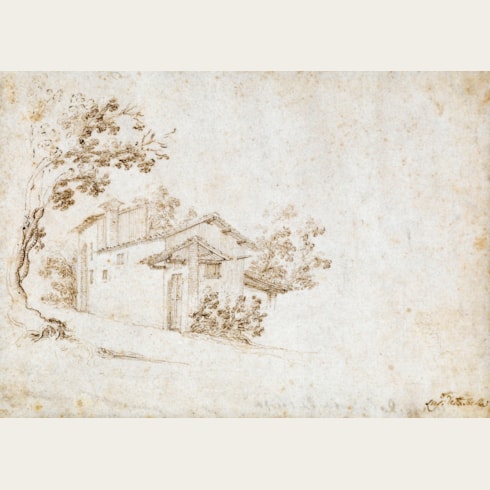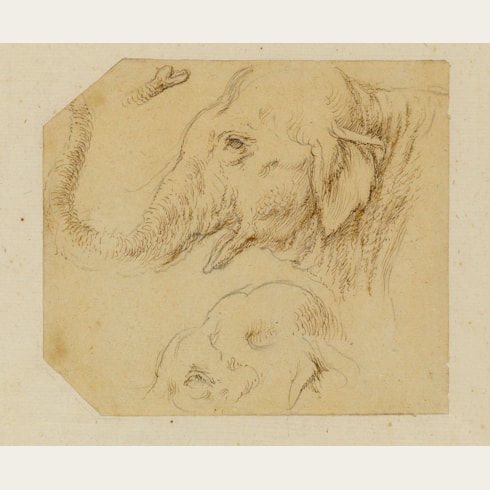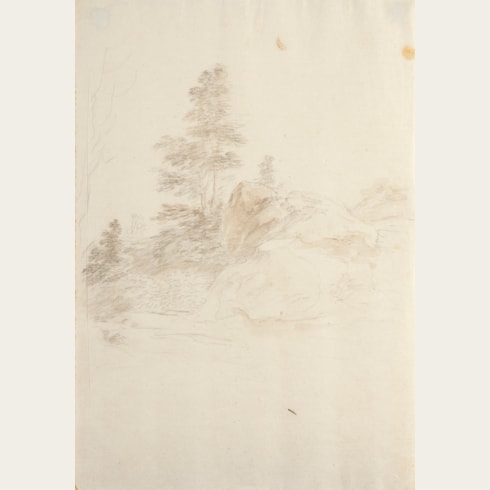Stefano DELLA BELLA
(Florence 1610 - Florence 1664)
The Head of an Elephant
The verso in pen and brown ink.
All four corners of the sheet cut.
Numbered 65 on the verso.
84 x 97 mm. (3 1/4 x 3 7/8 in.)
Named Hansken, the elephant depicted in this drawing was well known throughout Europe. He was born in Ceylon in 1630, and three years later arrived in Amsterdam aboard a Dutch East India Company ship, as a young animal. For the next twenty-one years - between 1634 and 1655 - Hansken was displayed in cities in Holland, Germany, Poland, Russia, Denmark, France, Switzerland and Italy. He died in Florence in November 1655, and his skeleton is today on display in the Museo di Storia Naturale ‘La Speccola’ in Florence.
The elephant Hansken was depicted in a number of drawings by Rembrandt, drawn in Amsterdam in 1637, and by Stefano della Bella, who may have first seen the creature in Paris and possibly also later in Holland. Della Bella also made a number of drawings of Hansken at his death; one of these, inscribed and dated ‘Elefante morto in Firenze addi 9 di novembre 1655’, is now in the Biblioteca Reale in Turin. Two other studies of the lifeless creature are in the collection of the Stadel Museum in Frankfurt. Another drawing of the elephant is in the Albertina in Vienna, while a handful of studies of Hansken were, like the present sheet, included in the Tomkins album of drawings by della Bella, which was sold at auction in 1975.
This drawing was once part of an important album of drawings by Stefano della Bella assembled by the English calligrapher Thomas Tomkins (1743-1816)6. Containing a large and representative selection of the artist’s drawings from the entire course of his career, the album is first recorded in 1818 at the posthumous sale of the Tomkins collection. The Tomkins album was later acquired by the prominent collector and connoisseur Robert Staynor Holford (1808-1892), and remained intact in the Holford collection until its sale at auction in London in 1928, when some of the drawings were removed from the album. Nevertheless, 241 of the della Bella drawings assembled by Tomkins, including the present pair, remained together as a group until they were finally dispersed at auction in London in 1975. As was noted in the catalogue of that sale, ‘the Tomkins album is comparable in range and importance with the great holdings of Stefano drawings in the Louvre, the Uffizi, the Hermitage and the Royal Collection.’
A gifted draughtsman and designer, Stefano della Bella was born into a family of artists. Apprenticed to a goldsmith, he later entered the workshop of the painter Giovanni Battista Vanni, and also received training in etching from Remigio Cantagallina. He came to be particularly influenced by the work of Jacques Callot, although it is unlikely that the two artists ever actually met. Della Bella’s first prints date to around 1627, and he eventually succeeded Callot as Medici court designer and printmaker, his commissions including etchings of public festivals, tournaments and banquets hosted by the Medici in Florence. Under the patronage of the Medici, Della Bella was sent in 1633 to Rome, where he made drawings after antique and Renaissance masters, landscapes and scenes of everyday life.
In 1639 he accompanied the Medici ambassador to the Parisian court of Louis XIII, and remained in France for ten years. Della Bella established a flourishing career in Paris, publishing numerous prints and obtaining significant commissions from Cardinals Richelieu and Mazarin, as well as other members of the court and the aristocracy. Indeed, the majority of his prints date from this fertile Parisian period, and include scenes of life at the French court. After his return to Florence in 1650, Della Bella continued to enjoy Medici patronage. Over the next few years he produced drawings of the gardens of the Medici villa at Pratolino, the port of Livorno and the Villa Medici in Rome, and also became the drawing master to the future Duke, Cosimo III. He was also active as a designer of costumes for the various pageants, masquerades and ballets of the Medici court. After suffering a stroke in 1661, Della Bella appears to have worked very little before his death three years later.
Only a handful of paintings by Della Bella survive to this day, and it is as a graphic artist that he is best known. A hugely talented and prolific printmaker and draughtsman, he produced works of considerable energy and inventiveness, with an oeuvre numbering over a thousand etchings, and many times more drawings and studies. Significant groups of drawings by Della Bella are today in several public collections, with around six hundred sheets in both the Uffizi and the Louvre, and approximately 150 drawings apiece in the Istituto Nazionale per la Grafica in Rome and the Royal Collection at Windsor Castle.
Provenance
Literature





















